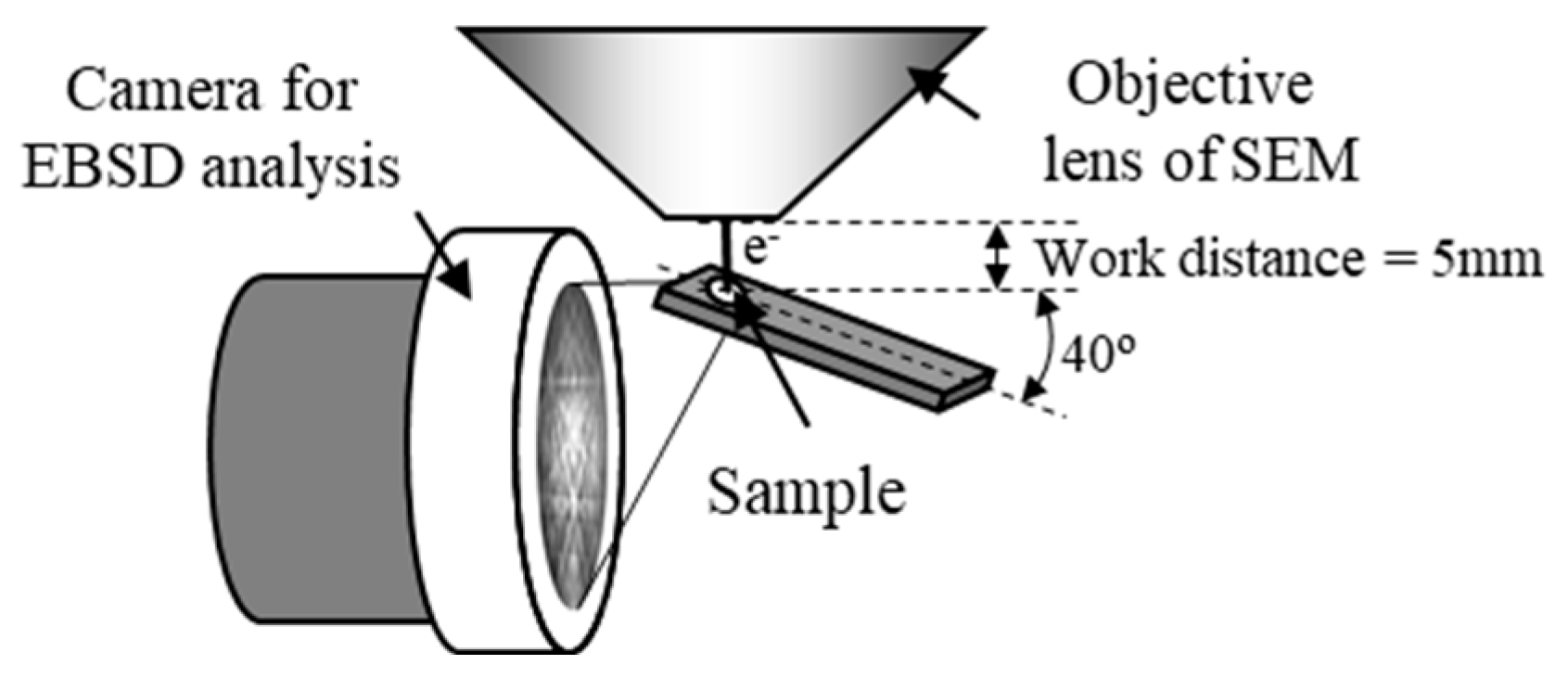Dissimilar Welding of Magnesium Alloys and Aluminum Alloys by Explosive Welding
Abstract
1. Introduction
2. Method of Explosive Welding
3. Characterization of Metallographic Structure at the Interface
3.1. Interfacial Microstructure
3.2. Characteristics of the Interlayer at the Interface
3.3. Grain Refinement in Magnesium Alloy Side
4. Effect of Magnesium Alloy Composition
4.1. Interfacial Microstructure
4.2. Characteristics of the Interlayer at the Interface
4.3. Shear Strength
4.4. Corrosion Resistance
5. Effect of Aluminum Alloy Compositions
5.1. Interfacial Microstructure and Characteristics of the Interlayer at the Interface
5.2. Shear Strength
6. Effect of Annealing After Explosive Welding
6.1. Characteristics of the Interlayer at the Interface
6.2. Shear Strength
6.3. Nano-Hardness Across the Interface
7. Future Challenges
- (1)
- Clarification of formation and growth mechanisms of the interlayer
- (2)
- Detailed Analysis of Recrystallization Behavior and Grain Size Changes
- (3)
- Shear Strength and Failure Mechanisms
- (4)
- Corrosion Mechanisms and Behavior
- (5)
- Detailed Evaluation of the Effects of Annealing Treatment
8. Conclusions
- (1)
- A wavy interface was observed at the bonding interface, resulting from the shear flow parallel to the direction of explosive welding and displacement restraint in the vertical direction. On the magnesium alloy side, fine recrystallized grains were generated by explosive welding.
- (2)
- At the interface of the AZ31/A6005C cladding plate, a thin interlayer was formed, and the presence of the γ-Mg17Al12 phase was confirmed within it. The thickness of the interlayer was non-uniform, ranging from 30 to 95 nm. As the aluminum concentration in the magnesium alloy increased, the thickness of the interlayer also increased. The thicknesses in the AZ61/A6005C and AZ80/A6005C cladding plates were approximately 0.5 μm and 0.7 μm, respectively. Moreover, as the magnesium concentration in the aluminum alloy increased, the thickness of the interlayer further increased. The thicknesses in the AZ31/A5052 and AZ80/A5052 cladding plates were approximately 2.0 µm and 6.0 µm, respectively.
- (3)
- Shear strength increased in the order of AZ31/A6005C, AZ31/A5052, AZ80/A6005C, and AZ80/A5052. The AZ80/A6005C cladding plate, where an interlayer was uniformly formed at the interface, exhibited a higher shear strength than the AZ31/A6005C cladding plate, where a thin, uneven interlayer was present at the interface. In contrast, the shear strength of AZ80/A5052, which had a thicker interlayer, was lower than that of AZ80/A6005C. Thus, the shear strength decreases when the thickness of the interlayer exceeds a certain value.
- (4)
- Regarding corrosion resistance, the weight loss of the corrosion of the explosively welded cladding plates was slightly smaller than that of the mechanically fastened samples, indicating that corrosion progresses more easily with the mechanically fastened samples than with the explosively welded cladding plates.
- (5)
- Annealing for the AZ80/A6005C cladding plates increased the thickness of the interlayer to about 2–4 μm. The γ-Mg17Al12 phase -Mg17Al12 was observed in the samples before annealing and after annealing at 373 K, and a new Al-rich β-Al3Mg2 phase was formed on the A6005C side after annealing at 473 K. The β-Al3Mg2 phase was hard and brittle, acting as a fracture initiation site and consequently reducing the shear strength.
Author Contributions
Funding
Acknowledgments
Conflicts of Interest
References
- Kayode, O.; Akinlabi, E.T. An overview on joining of aluminium and magnesium alloys using friction stir welding (FSW) for automotive lightweight applications. Mater. Res. Express 2019, 6, 112005. [Google Scholar] [CrossRef]
- Ben-Artzy, A.; Munitz, A.; Kohn, G.; Bronfin, B.; Shtechman, A. Joining of light hybrid constructions made of magnesium and aluminum alloys. Magnes. Technol. 2002, 2022, 295–302. [Google Scholar]
- Liu, P.; Li, Y.; Geng, H.; Wang, J. Microstructure characteristics in TIG welded joint of Mg/Al dissimilar materials. Mater. Lett. 2007, 61, 1288–1291. [Google Scholar] [CrossRef]
- Bannour, S.; Abderrazak, K.; Mattei, S.; Masse, J.E.; Autric, M.; Mhiri, H. The influence of position in overlap joints of Mg and Al alloys on microstructure and hardness of laser welds. J. Laser Appl. 2013, 25, 032001. [Google Scholar] [CrossRef]
- Zhang, J.; Luo, G.; Wang, Y.; Shen, Q.; Zhang, L. An investigation on diffusion bonding of aluminum and magnesium using a Ni interlayer. Mater. Lett. 2012, 83, 189–191. [Google Scholar] [CrossRef]
- Panteli, A.; Robson, J.D.; Brough, I.; Prangnell, P.B. The effect of high strain rate deformation on intermetallic reaction during ultrasonic welding Aluminium to Magnesium. Mater. Sci. Eng. A 2012, 556, 31–42. [Google Scholar] [CrossRef]
- Pati, P.R.; Satpathy, M.P.; Pattanaik, A.; Mohapatra, S.K.; Mishra, S.B. Ultrasonic spot welding of Al/Mg alloys: A state-of-the-art review. Mater. Today Proc. 2020, 33, 4981–4987. [Google Scholar] [CrossRef]
- Hayat, F. The effects of the welding current on heat input, nugget geometry, and the mechanical and fractural properties of resistance spot welding on Mg/Al dissimilar materials. Mater. Des. 2011, 32, 2476–2484. [Google Scholar] [CrossRef]
- Sidhu, R.S.; Kumar, R.; Kumar, R.; Goel, P.; Singh, S.; Pimenov, D.Y.; Giasin, K.; Adamczuk, K. Joining of Dissimilar Al and Mg Metal Alloys by Friction Stir Welding. Materials 2022, 15, 5901. [Google Scholar] [CrossRef] [PubMed]
- Liu, L.; Daxin, R.; Fei, L. A review of dissimilar welding techniques for magnesium alloys to aluminium alloys. Materials 2014, 7, 3735–3757. [Google Scholar] [CrossRef] [PubMed]
- Zettler, R. Dissimilar Al to Mg alloy friction stir welds. Adv. Eng. Mater. 2006, 8, 415–421. [Google Scholar] [CrossRef]
- Massalski, T.B. (Ed.) Binary Alloy Phase Diagrams, 2nd ed.; ASM International: Materials Park, OH, USA, 1990; pp. 169–171. [Google Scholar]
- Mihara-Narita, M.; Mori, H.; Sato, H.; Watanabe, Y.; Saito, N.; Chino, Y.; Keno, H.; Yamada, Y.; Minoda, T.; Tanaka, H. Characterization of metallographic structure of interface on explosively welded magnesium alloy/aluminum alloy clad materials. J. Light Met. Weld. 2022, 60, 38–45. [Google Scholar]
- Asai, K.; Mihara-Narita, M.; Sato, H.; Watanabe, Y.; Mori, H.; Saito, N.; Nakatsugawa, I.; Chino, Y. Effect of magnesium alloy compositions on the interfacial microstructure, corrosion resistance and mechanical properties of explosively welded magnesium/aluminum alloys. J. Jpn. Inst. Light Met. 2022, 72, 255–264. [Google Scholar] [CrossRef]
- Mihara-Narita, M.; Asai, K.; Mori, H.; Chino, Y.; Sato, H.; Watanabe, Y. Relationship between interfacial microstructure and shear strength of explosively welded Mg/Al alloy plates with different alloy compositions. Prepr. Natl. Meet. JWS 2022, 111, 50–51. [Google Scholar]
- Mihara-Narita, M.; Asai, K.; Mori, H.; Saito, N.; Chino, Y.; Sato, H.; Watanabe, Y. Effects of annealing on the Interfacial microstructure and mechanical properties of explosively welded AZ80 magnesium alloy and A6005C aluminum alloy. Q. J. Jpn. Weld. Soc. 2023, 41, 107–115. [Google Scholar] [CrossRef]
- Hokamoto, K.; Chiba, A.; Fujita, M. Single-shot explosive welding technique for the fabrication of multilayered metal base composites: Effect of welding parameters leading to optimum bonding condition. Compos. Eng. 1995, 5, 1069–1079. [Google Scholar] [CrossRef]
- Corigliano, P.; Crupi, V.; Guglielmino, E.; Sili, A.M. Full-field analysis of Al/Fe explosive welded joints for shipbuilding applications. Mar. Struct. 2018, 57, 207–218. [Google Scholar] [CrossRef]
- Yan, Y.B.; Zhang, Z.W.; Shen, W.; Wang, J.H.; Zhang, L.K.; Chin, B.A. Microstructure and properties of magnesium AZ31B–aluminum 7075 explosively welded composite plate. Mater. Sci. Eng. 2010, A527, 2241–2245. [Google Scholar] [CrossRef]
- Sahul, M.; Sahul, M.; Lokaj, J.; Caplovic, L.; Nesvadba, P.; Odokienova, B. The effect of annealing on the properties of AW5754 aluminum alloy-AZ31B magnesium alloy explosively welded bimetals. J. Mater. Sci. 2019, 28, 6192–6208. [Google Scholar] [CrossRef]
- Zhang, T.; Wang, W.; Zhang, W.; Wei, Y.; Cao, X.; Yan, Z.; Zhou, J. Microstructure evolution and mechanical properties of an AA6061/AZ31B alloy plate fabricated by explosive welding. J. Alloys Compd. 2018, 735, 1759–1768. [Google Scholar] [CrossRef]
- Bataev, I.A.; Tanaka, S.; Zhou, Q.; Lazurenko, D.V.; Junior, A.J.; Bataev, A.A.; Chen, P. Towards better understanding of explosive welding by combination of numerical simulation and experimental study. Mater. Des. 2019, 169, 107649. [Google Scholar] [CrossRef]
- Ghaderi, S.H.; Mori, A.; Hokamoto, K. Analysis of explosively welded aluminum–AZ31 magnesium alloy joints. Mater. Trans. 2008, 49, 1142–1147. [Google Scholar] [CrossRef]
- Chen, P.; Feng, J.; Zhou, Q.; An, E.; Li, J.; Yuan, Y.; Ou, S. Investigation on the explosive welding of 1100 aluminum alloy and AZ31 magnesium alloy. J. Mater. Eng. Perform. 2016, 25, 2635–2641. [Google Scholar] [CrossRef]
- Onzawa, T. The mechanism of wave formation in explosively bonded interface. J. Jpn. High Press. Inst. 1975, 13, 103–109. [Google Scholar]
- Zhang, T.; Wang, W.; Zhang, W.; Zhou, J.; Yan, Z. Interfacial microstructure evolution and deformation mechanism in an explosively welded Al/Mg alloy plate. J. Mater. Sci. 2019, 54, 9155–9167. [Google Scholar] [CrossRef]
- Reid, S.R.; Langdale, D.J. Investigation of the modulation of interface waves in explosive welding. In Proceedings of the Fifteenth International Machine Tool Design and Research Conference; Tobias, S.A., Koenigsberger, F., Eds.; Springer: Berlin/Heidelberg, Germany, 1975; pp. 391–398. [Google Scholar]
- Gotoh, M.; Yamashita, M.; Ohno, M. An evidence of melting along adiabatic shear band in high-speed shearing process. Trans. Jpn. Soc. Mech. Eng. Ser. A 1992, 58, 1979–1984. [Google Scholar] [CrossRef][Green Version]
- Akbari Mousawi, S.A.A.; Al-Hassani, S.T.S.; Atkins, A.G. Bond strength of explosively welded specimens. Mater. Des. 2008, 29, 1334–1352. [Google Scholar] [CrossRef]
- Cowperthwaite, M. Compression and Shear Wave Propagation in Explosives; Final Report 7’; U.S. Army Research Office: Durham, NC, USA, 1989; pp. 70–73. [Google Scholar]
- Wronka, B. Testing of explosive welding and welded joints: Joint mechanism and properties of explosive welded joints. J. Mater. Sci. 2010, 45, 4078–4083. [Google Scholar] [CrossRef]
- Brennan, S.; Bermudez, K.; Kulkarni, N.S.; Sohn, Y. Interdiffusion in the Mg-Al system and intrinsic diffusion in β-Mg2Al3. Metall. Mater. Trans. A 2012, 43, 4043–4052. [Google Scholar] [CrossRef]
- Ishii, Y.; Onzawa, T.; Oinuma, T. A study of fusion layer in Explosive bonded boundary (Report 2). J. Jpn. Weld. Soc. 1969, 38, 1372–1378. [Google Scholar] [CrossRef] [PubMed][Green Version]
- Kamado, S. Physical and chemical properties of magnesium. J. Jpn. Inst. Light Met. 2009, 59, 216–224. [Google Scholar] [CrossRef]
- Suzuki, S. Features of Transmission EBSD and its Application. JOM 2013, 65, 1254–1263. [Google Scholar] [CrossRef]
- Watanabe, H.; Mukai, T.; Higashi, K. Research on superplasticity in magnesium. J. Jpn. Inst. Light Met. 2001, 51, 503–508. [Google Scholar] [CrossRef]
- Watanabe, H.; Tsutsui, H.; Mukai, T.; Ishikawa, K.; Okanda, Y.; Kohzu, M.; Higashi, K. Grain size control of commercial wrought Mg-Al-Zn alloys utilizing dynamic recrystallization. Mater. Trans. 2001, 42, 1200–1205. [Google Scholar] [CrossRef]
- Beyerlein, I.J.; Capolungo, L.; Marshall, P.E.; McCabe, R.J.; Tome, C.N. Statistical analyses of deformation twinning in magnesium. Philos. Mag. 2010, 90, 2161–2190. [Google Scholar] [CrossRef]
- Wang, J.; Beyerlein, I.J.; Tome, C.N. An atomic and probabilistic perspective on twin nucleation in Mg. Scr. Mater. 2010, 63, 741–746. [Google Scholar] [CrossRef]
- Hull, D. Effect of grain size and temperature on slip, twinning and fracture in 3% silicon iron. Acta Mater. 1961, 9, 191–204. [Google Scholar] [CrossRef]
- JIS G0601; Testing Methods for Clad Steels. Japanese Standards Association: Tokyo, Japan, 1977.
- Nakatsugawa, I.; Chino, Y. Effect of NaCl concentration on the galvanic corrosion behavior of a magnesium AZX611/aluminum A6N01 alloy joint. J. Electrochem. Soc. 2020, 167, 061501. [Google Scholar] [CrossRef]
- Nakatsugawa, I.; Chino, Y. Effect of area ratio on the galvanic corrosion of AZX611 magnesium alloy/A6N01 aluminum alloy joint. J. Jpn. Inst. Light Met. 2021, 71, 82–88. [Google Scholar] [CrossRef]
- Matsumoto, K.; Nishimoto, A.; Ishikawa, T.; Nagatsuta, K.; Ito, K.; Tsukamoto, M.; Nakata, K. Dissimilar materials joining of A6061 Al alloy and AZ31 Mg alloy by laser welding. J. Light Met. Weld. 2019, 57, 198–206. [Google Scholar]
- Yamamoto, N.; Liao, J.; Watanabe, S.; Nakata, K. Effect of intermetallic compound layer on tensile strength of dissimilar friction-stir weld of a high strength Mg alloy and Al alloy. Mater. Trans. 2009, 50, 2833–2838. [Google Scholar] [CrossRef]
- Su, Z.; Zhu, Z.; Zhang, Y.; Zhang, H. Analysis of microstructure and mechanical properties of AZ31B magnesium alloy/AA6061 aluminum alloy welded joint by ultrasonic welding. Mater. Res. 2021, 24, e20200488. [Google Scholar] [CrossRef]
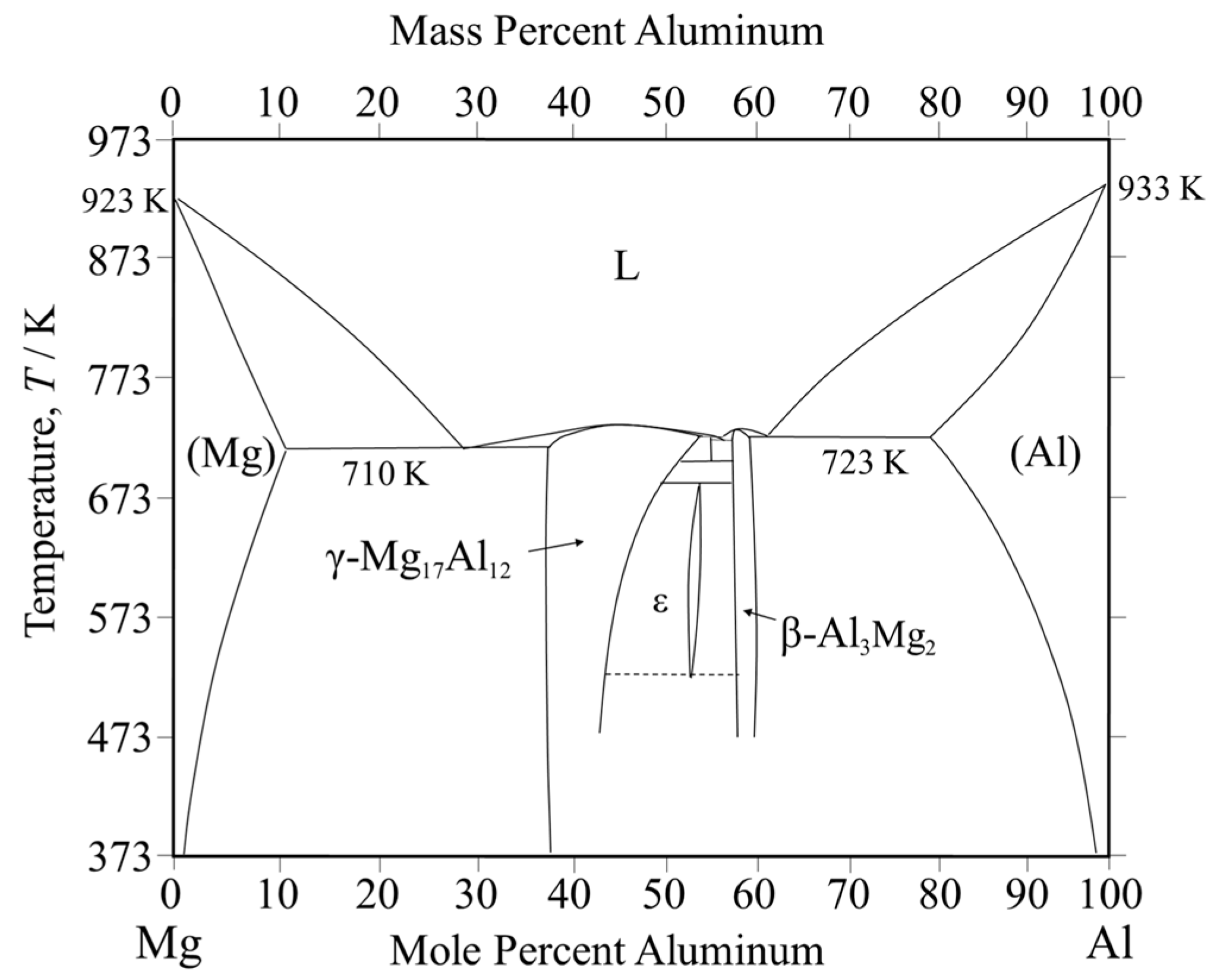



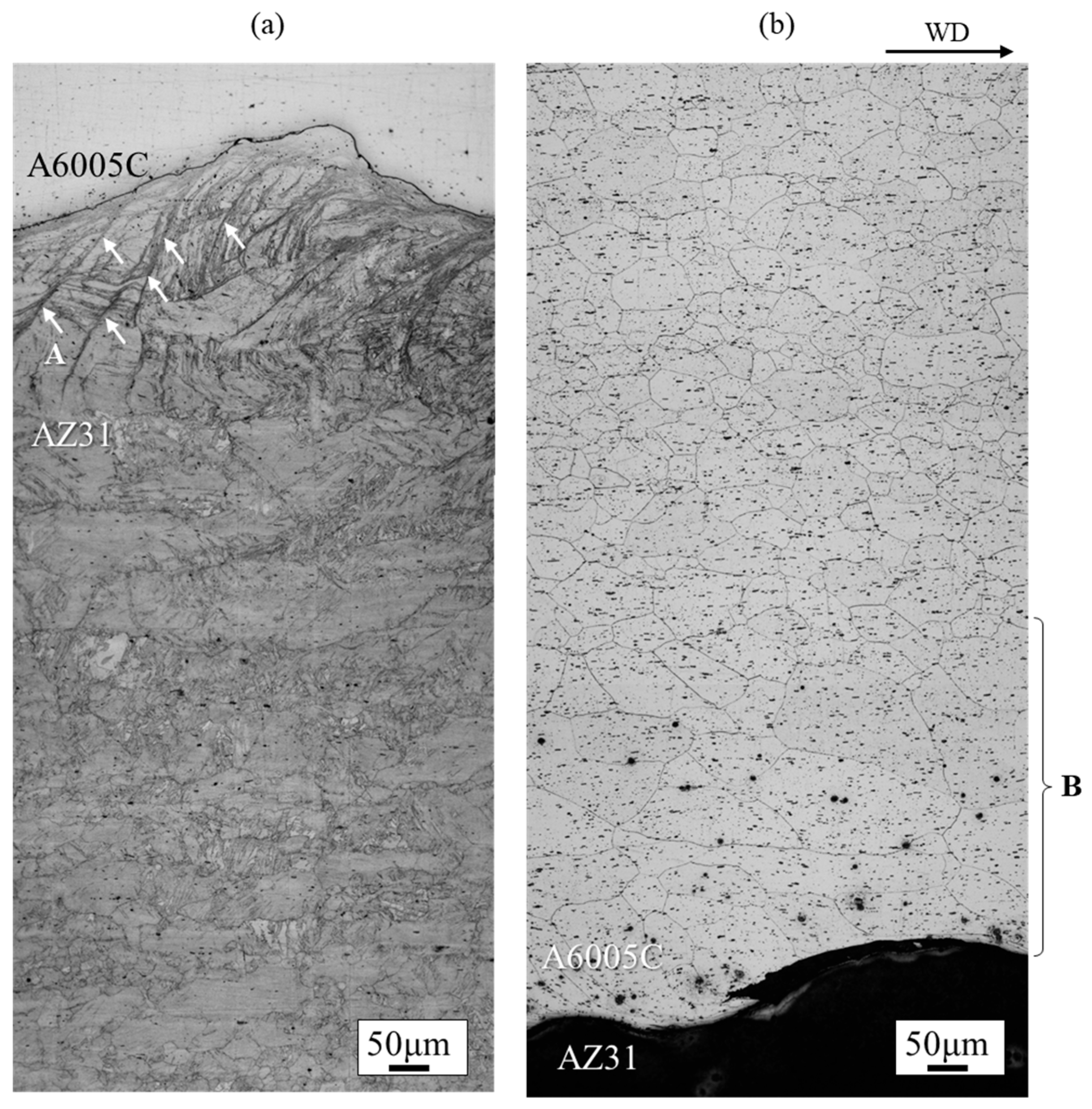
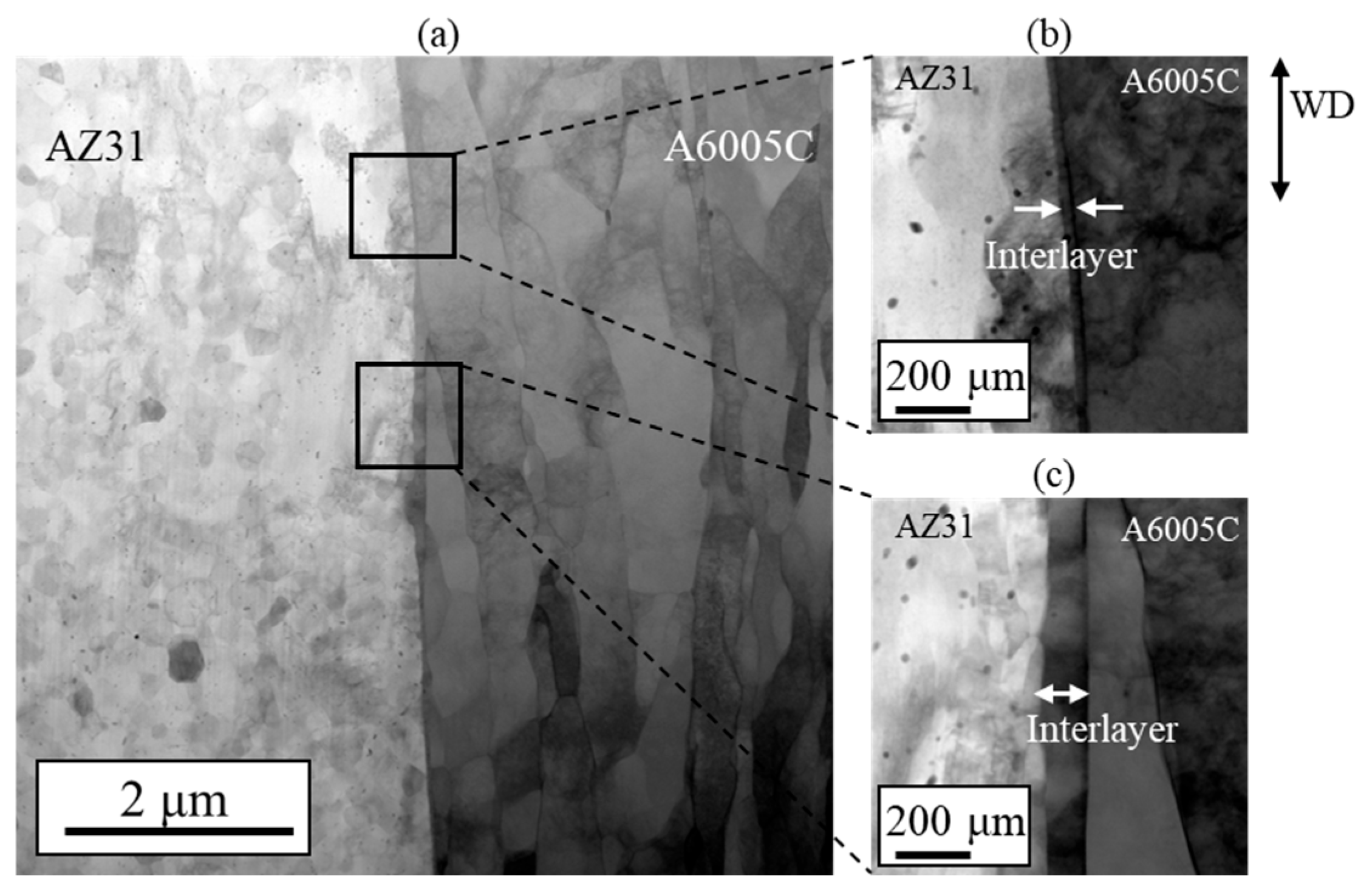

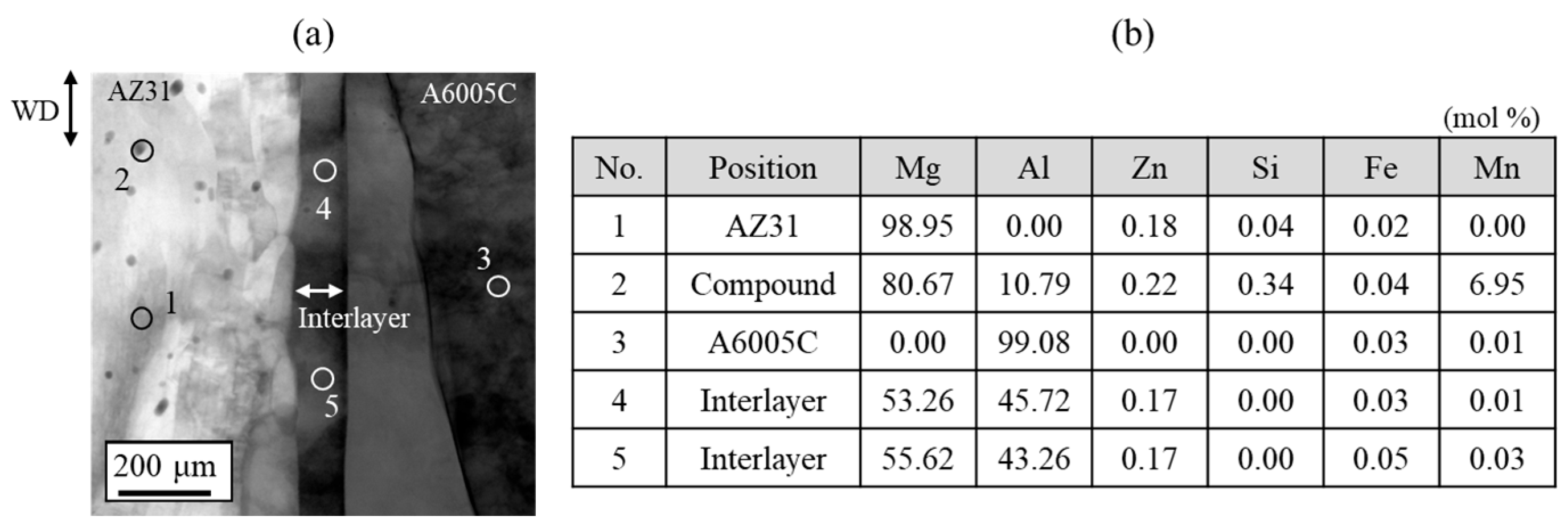
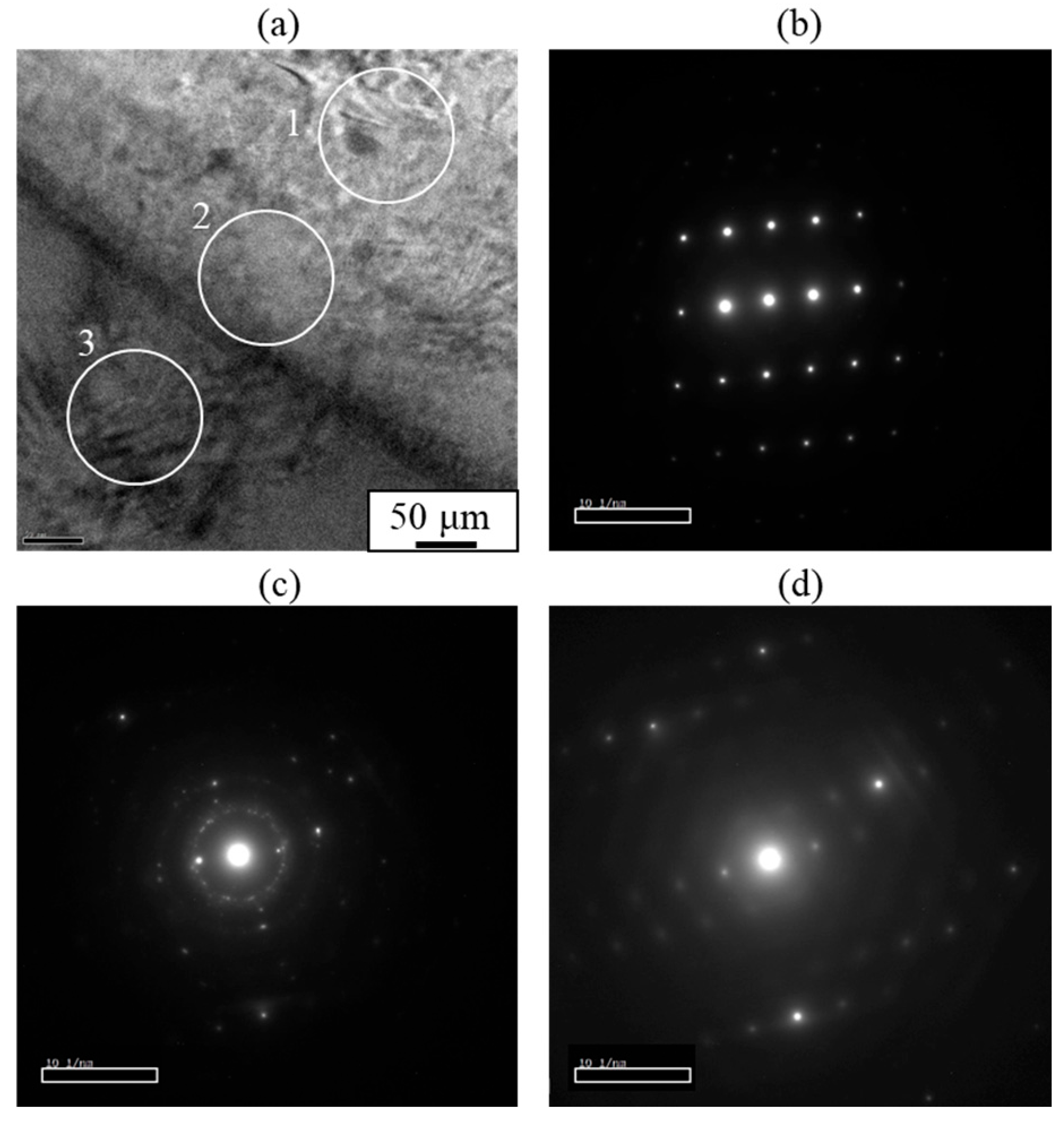

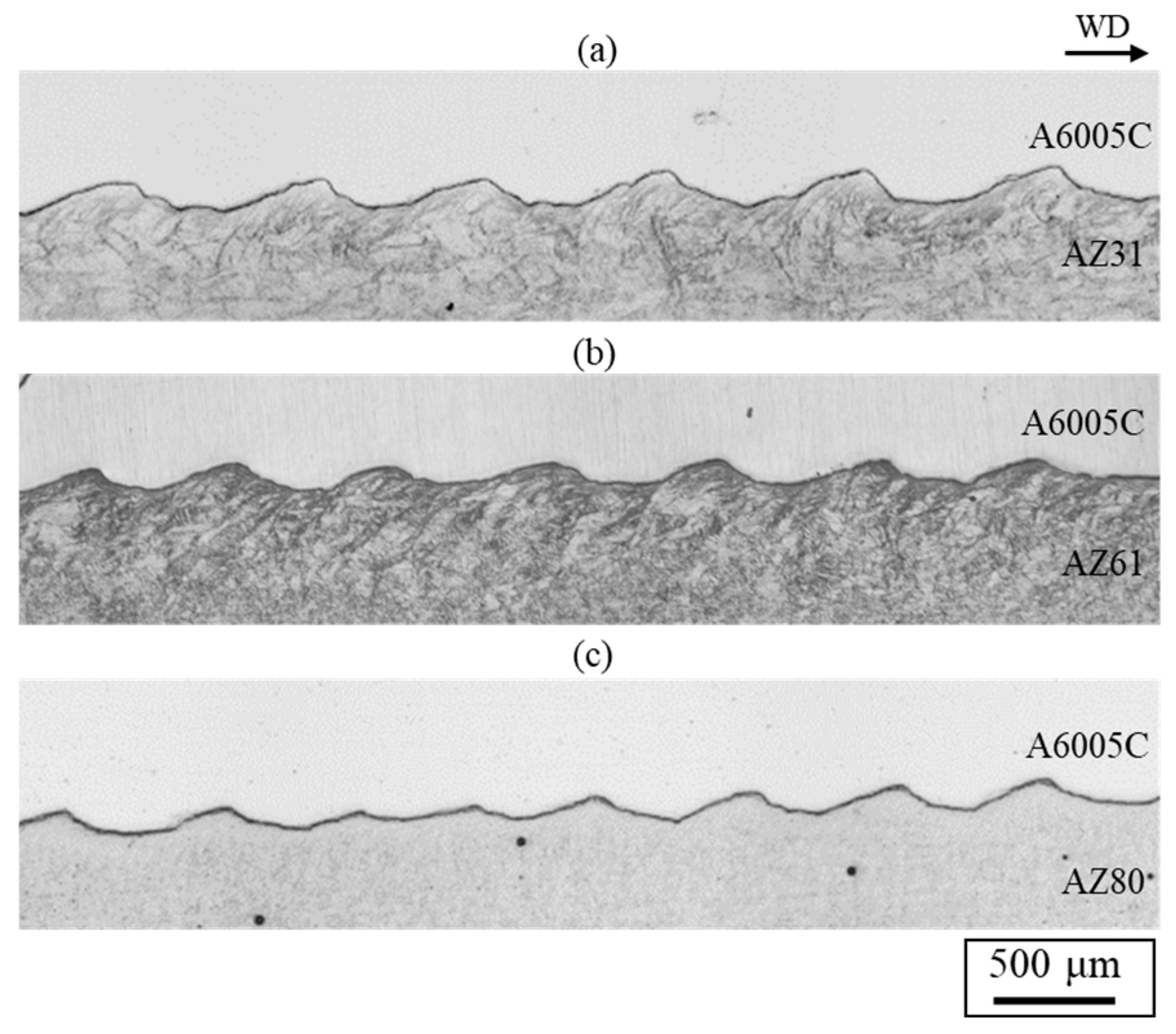
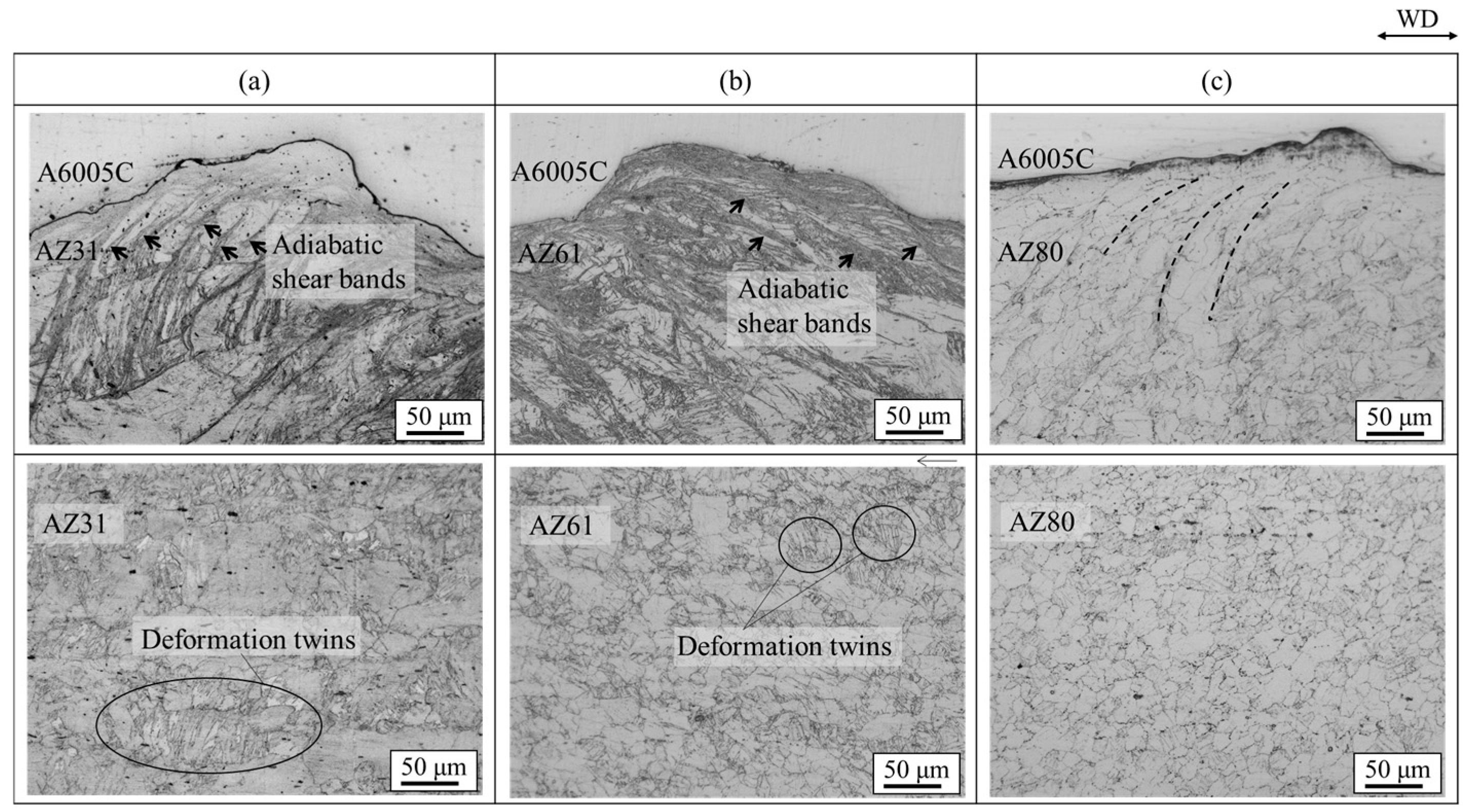


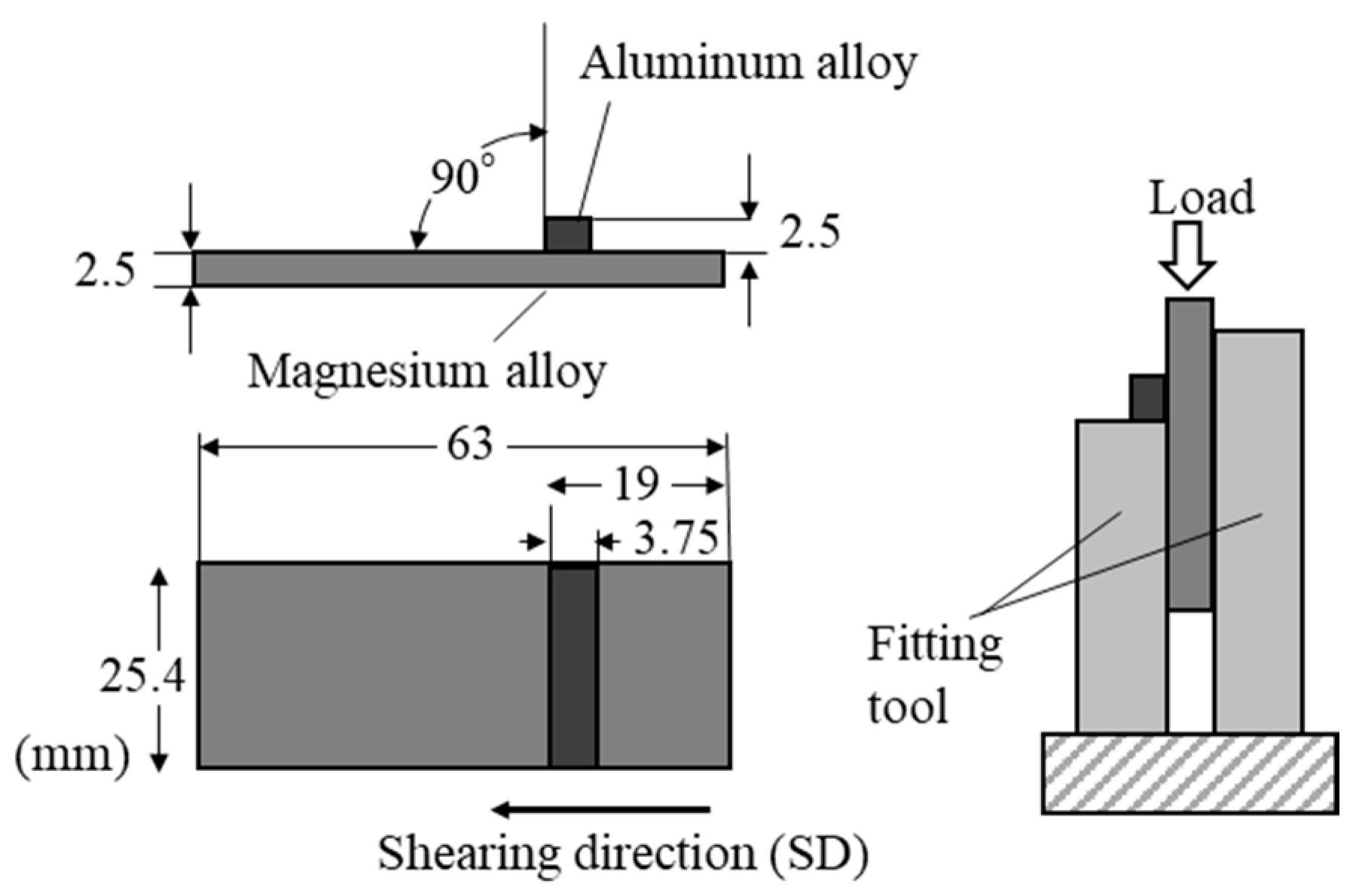


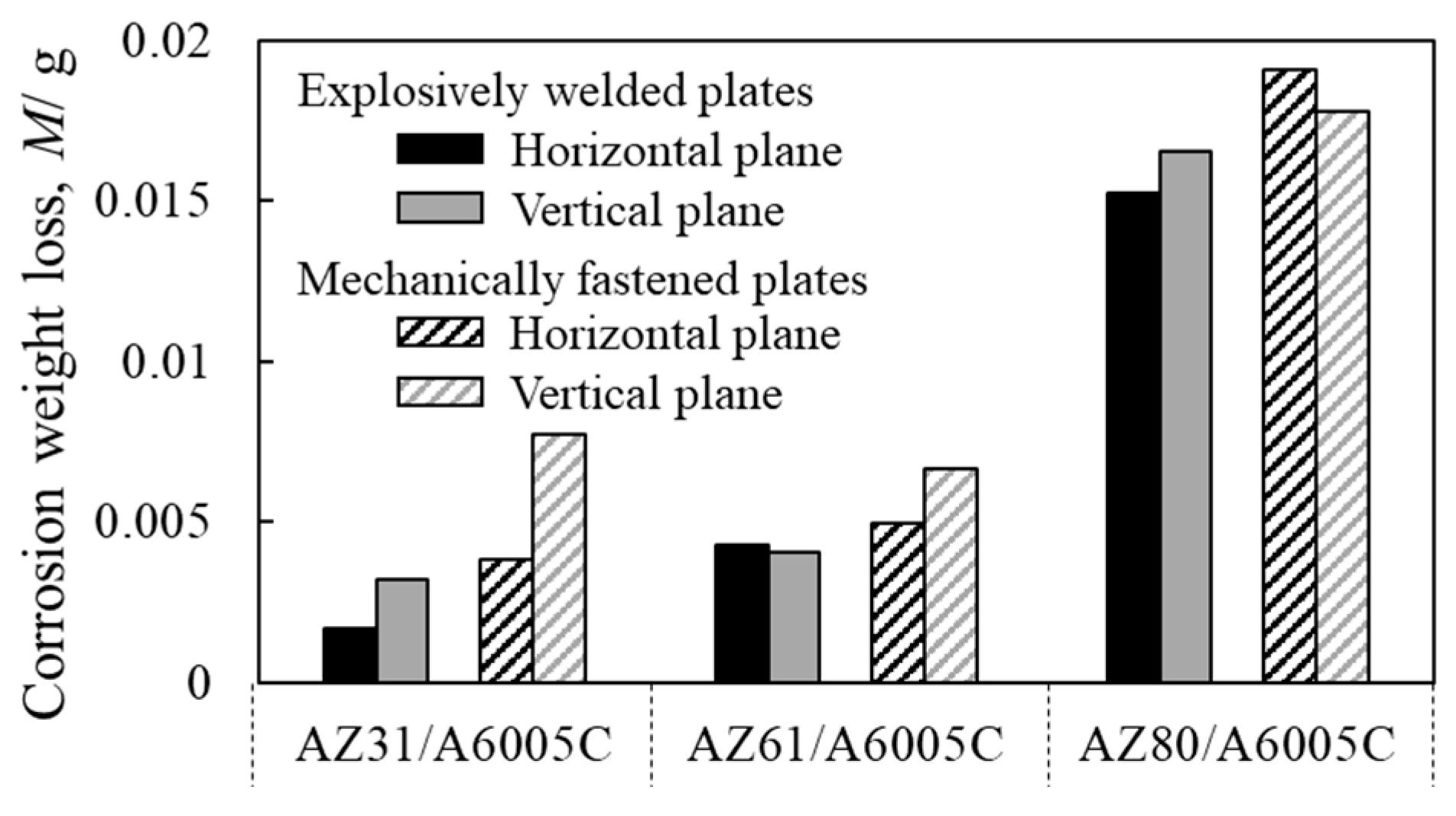
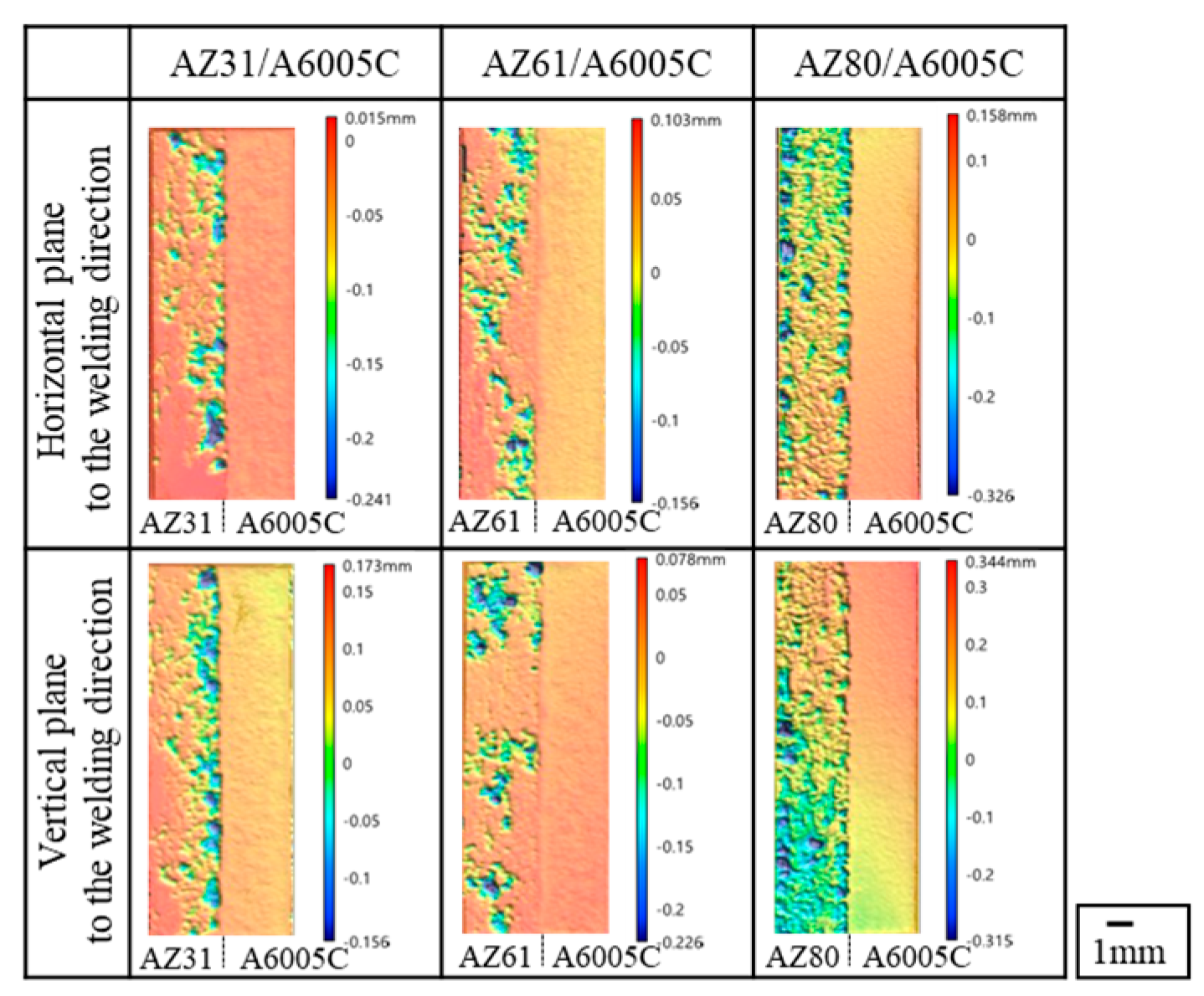
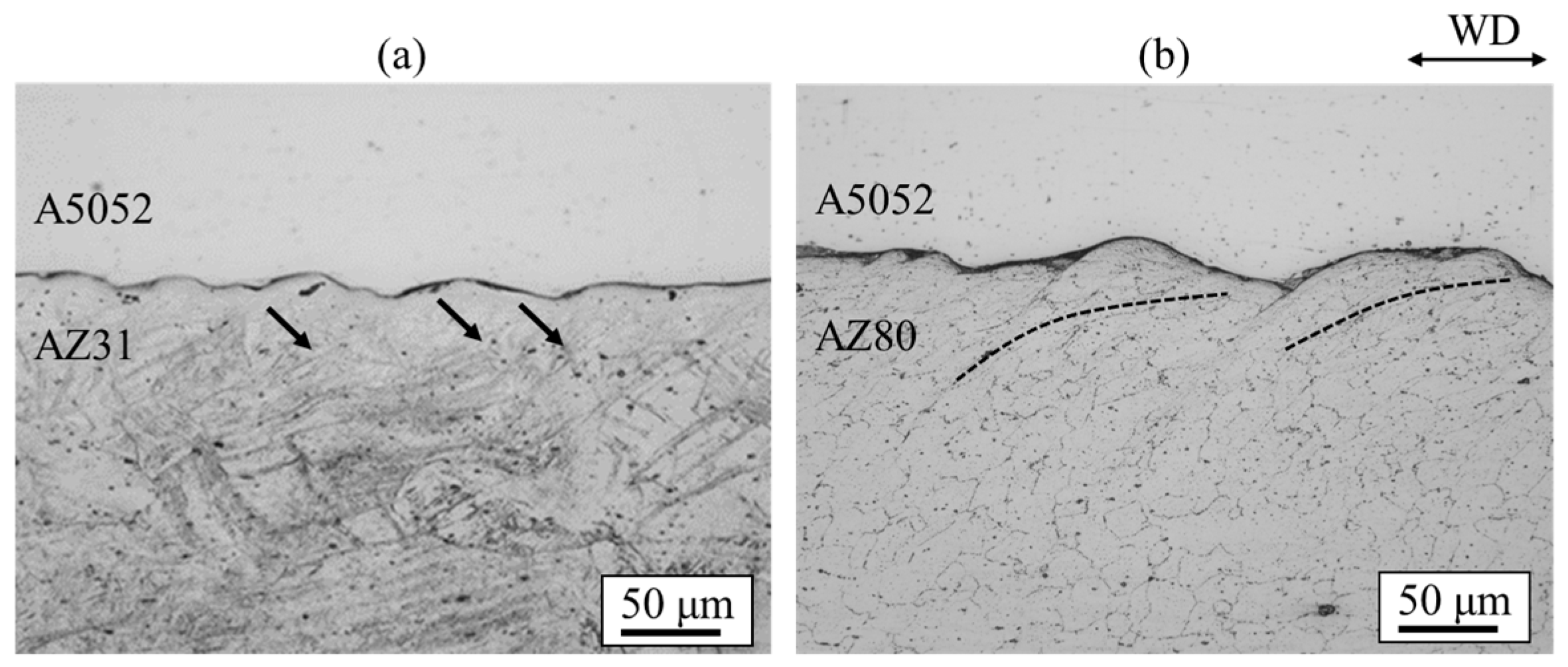

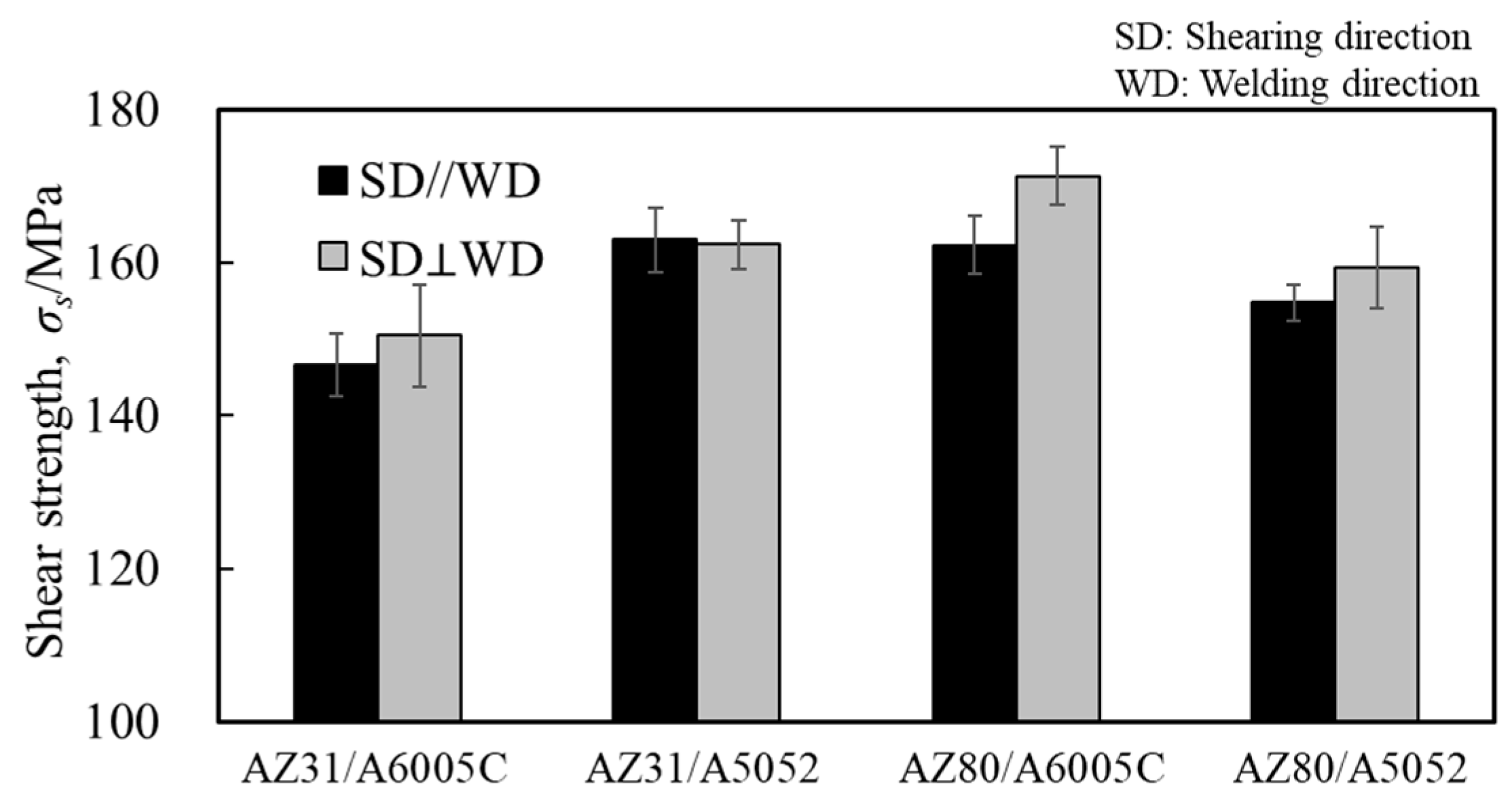
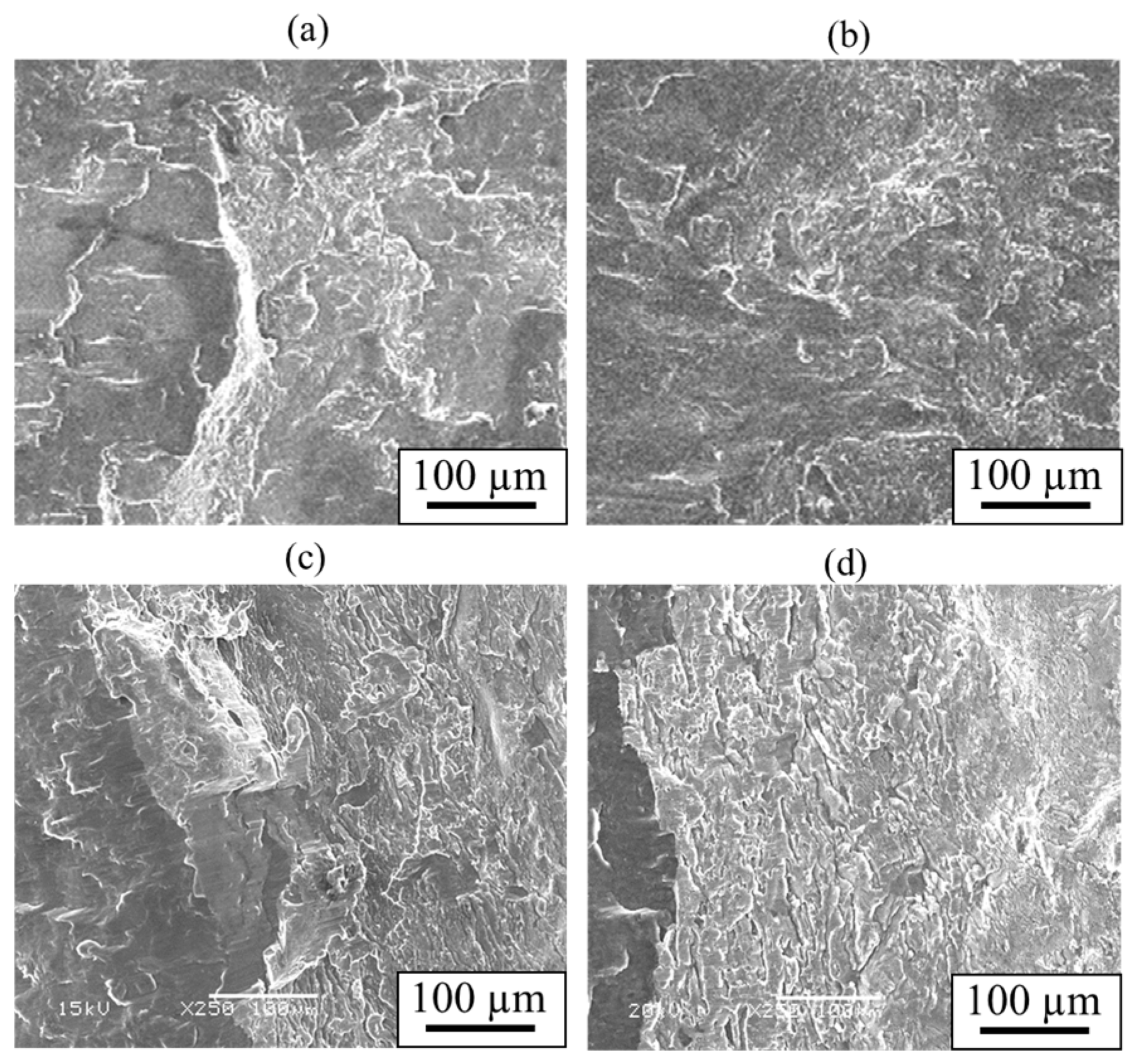

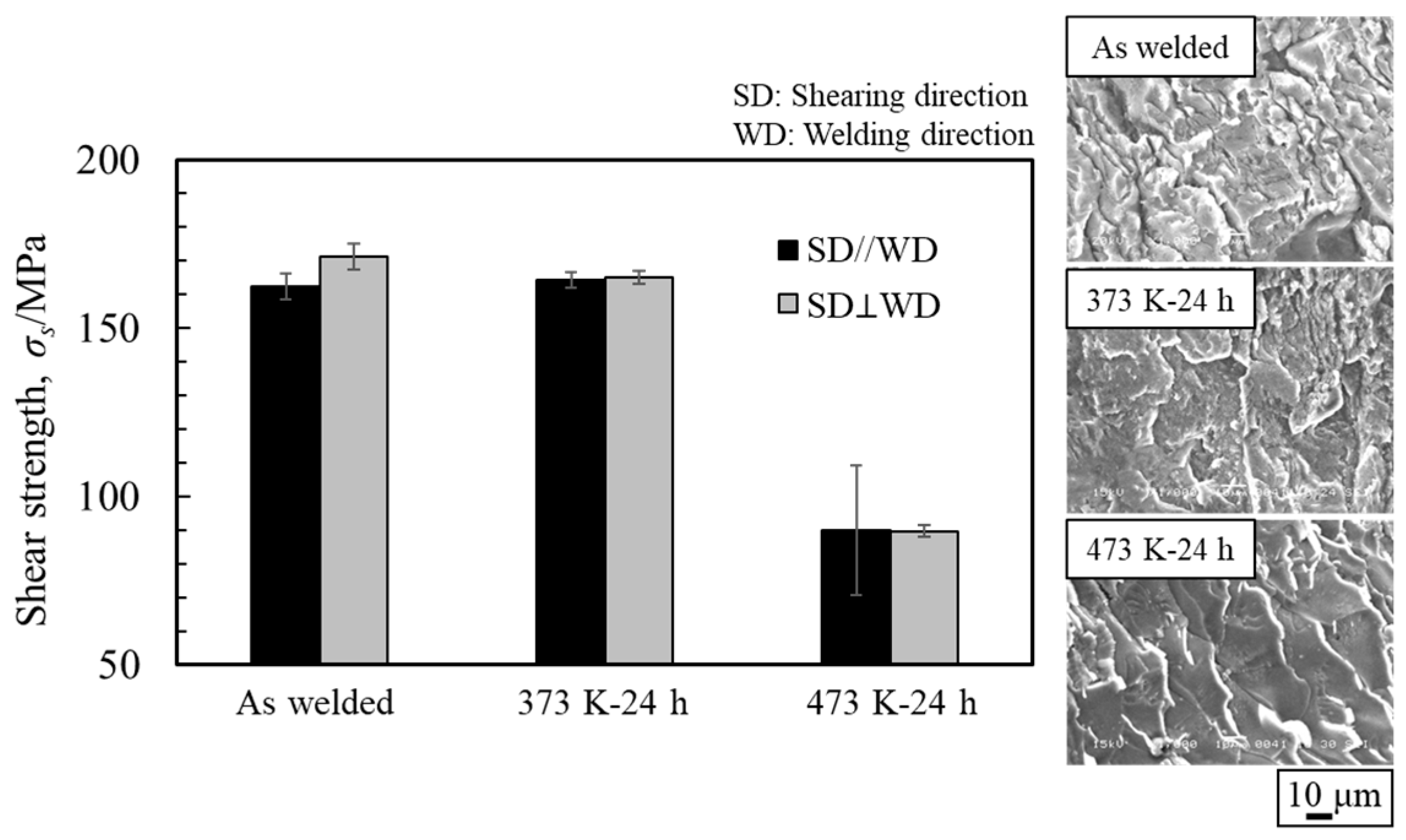
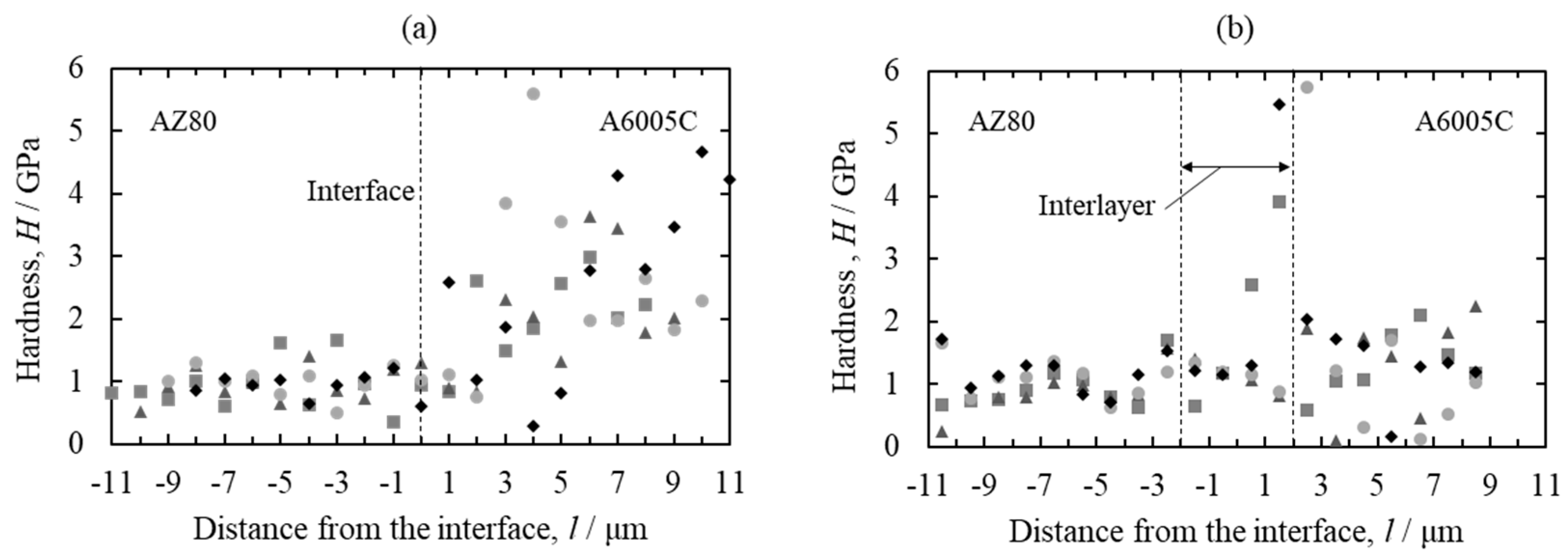
| Sample | Mg | Al | Zn | Si | Mn | Cu | Fe | Ni |
|---|---|---|---|---|---|---|---|---|
| AZ31 | Bal. | 3.0 | 0.9 | 0.02 | 0.3 | 0.002 | 0.004 | <0.002 |
| A6005C | 0.6 | Bal. | 0.00 | 0.6 | 0.01 | - | 0.1 | - |
| Sample | Mg | Al | Zn | Si | Mn | Cu | Fe | Ni |
|---|---|---|---|---|---|---|---|---|
| AZ31 | Bal. | 3.0 | 0.9 | 0.02 | 0.3 | 0.002 | 0.004 | <0.002 |
| AZ61 | Bal. | 5.7 | 0.7 | 0.02 | 0.3 | <0.002 | <0.002 | <0.002 |
| AZ80 | Bal. | 8.0 | 0.6 | 0.03 | 0.3 | <0.002 | 0.002 | <0.002 |
| A6005C | 0.6 | Bal. | 0.00 | 0.6 | 0.01 | - | 0.1 | - |
| Sample | Mg | Al | Zn | Si | Mn | Cu | Fe | Ni |
|---|---|---|---|---|---|---|---|---|
| AZ31 | Bal. | 3.0 | 0.9 | 0.02 | 0.3 | 0.002 | 0.004 | <0.002 |
| AZ80 | Bal. | 8.0 | 0.6 | 0.03 | 0.3 | <0.002 | 0.002 | <0.002 |
| A6005C | 0.6 | Bal. | 0.00 | 0.6 | 0.01 | - | 0.1 | - |
| A5052 | 2.58 | Bal. | 0.02 | 0.08 | 0.02 | - | 0.27 | - |
| Sample | Mg | Al | Zn | Si | Mn | Cu | Fe | Ni |
|---|---|---|---|---|---|---|---|---|
| AZ80 | Bal. | 8.0 | 0.6 | 0.03 | 0.3 | <0.002 | 0.002 | <0.002 |
| A6005C | 0.6 | Bal. | 0.00 | 0.6 | 0.01 | - | 0.1 | - |
Disclaimer/Publisher’s Note: The statements, opinions and data contained in all publications are solely those of the individual author(s) and contributor(s) and not of MDPI and/or the editor(s). MDPI and/or the editor(s) disclaim responsibility for any injury to people or property resulting from any ideas, methods, instructions or products referred to in the content. |
© 2025 by the authors. Licensee MDPI, Basel, Switzerland. This article is an open access article distributed under the terms and conditions of the Creative Commons Attribution (CC BY) license (https://creativecommons.org/licenses/by/4.0/).
Share and Cite
Mihara-Narita, M.; Asai, K.; Sato, H.; Watanabe, Y.; Nakatsugawa, I.; Saito, N.; Chino, Y. Dissimilar Welding of Magnesium Alloys and Aluminum Alloys by Explosive Welding. Materials 2025, 18, 1013. https://doi.org/10.3390/ma18051013
Mihara-Narita M, Asai K, Sato H, Watanabe Y, Nakatsugawa I, Saito N, Chino Y. Dissimilar Welding of Magnesium Alloys and Aluminum Alloys by Explosive Welding. Materials. 2025; 18(5):1013. https://doi.org/10.3390/ma18051013
Chicago/Turabian StyleMihara-Narita, Mami, Konosuke Asai, Hisashi Sato, Yoshimi Watanabe, Isao Nakatsugawa, Naobumi Saito, and Yasumasa Chino. 2025. "Dissimilar Welding of Magnesium Alloys and Aluminum Alloys by Explosive Welding" Materials 18, no. 5: 1013. https://doi.org/10.3390/ma18051013
APA StyleMihara-Narita, M., Asai, K., Sato, H., Watanabe, Y., Nakatsugawa, I., Saito, N., & Chino, Y. (2025). Dissimilar Welding of Magnesium Alloys and Aluminum Alloys by Explosive Welding. Materials, 18(5), 1013. https://doi.org/10.3390/ma18051013






